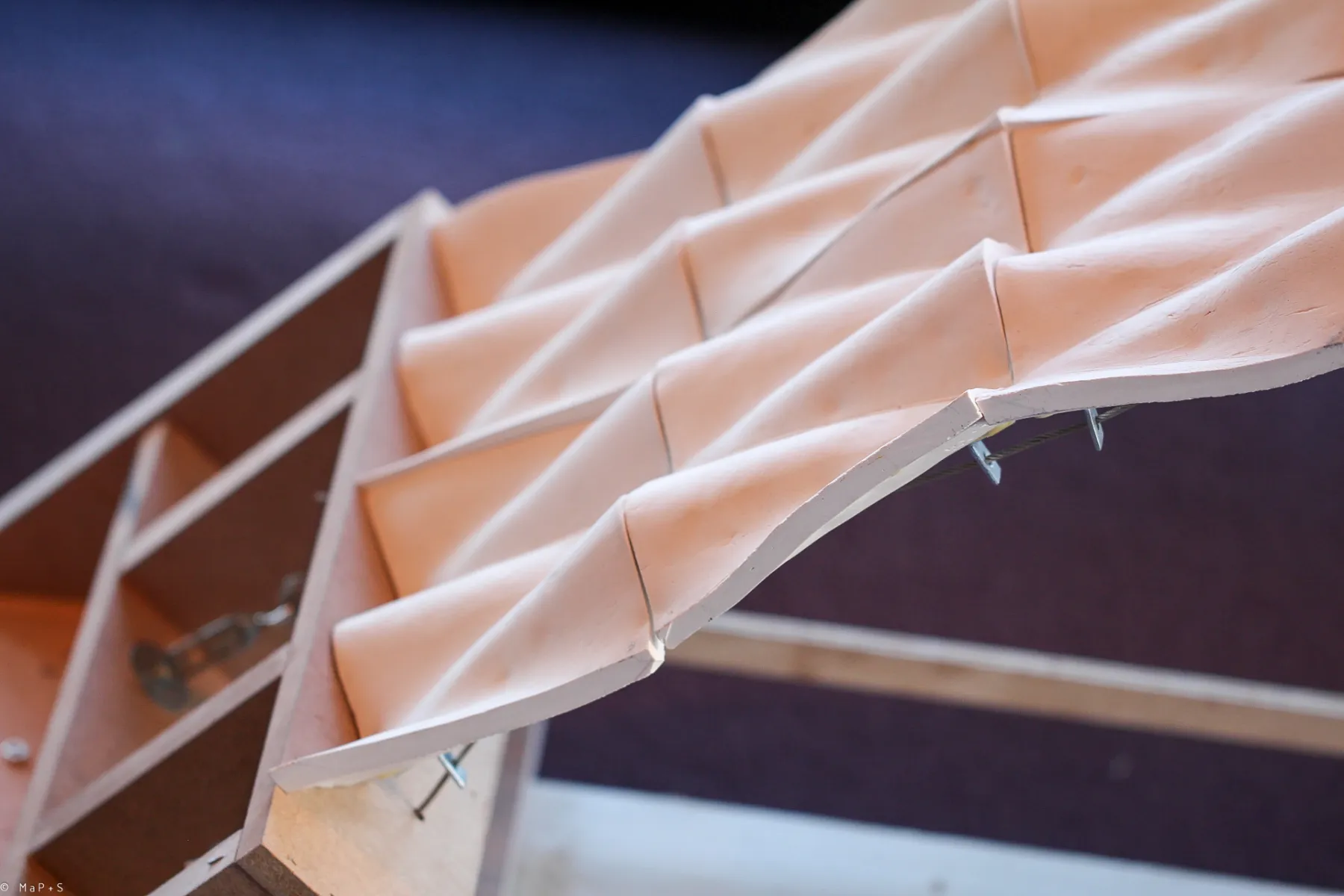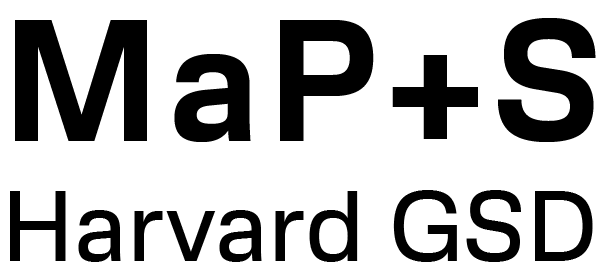
Courses
MaP+S faculty are offering a variety of courses related to materials, computation and perception.
Below is a selection of these courses:
SCI-6229
Structural Design II
Instructor: Martin Bechthold
Course Description
This course is a continuation of GSD 6227 and completes the introduction to the analysis and design of building structures. Both 6227 and 6229 are the required courses to satisfy (and exceed) accreditation requirements for structures in the MArch I program.
The course has three closely related pedagogical components. First, it introduces additional methods for structural analysis and design—numerical analysis techniques, physical model analysis, ultimate strength design of reinforced concrete elements, and structural design software.
Second, it completes the introduction to the elements of structures by introducing 3-D trusses, continuous beams, statically indeterminate frames, shells, and membranes. In addition to timber and steel, we introduce the design of reinforced concrete structures.
Finally, this course dedicates a significant amount of time to the design of structural systems, addressing both gravity as well as lateral loading scenarios. The design of structural systems is not treated as a purely quantitative exercise but as a design activity that synergizes architectural design and the mechanics of structural principles. Design exercises and case study analysis serve to expose the relationship between structural systems and architectural form and space. Students will learn to identify typical design strategies for structural system strategies and understand their spatial and formal ramifications. They will learn to select and apply appropriate methods of analysis when conducting structural analysis studies in order to make informed decisions throughout the architectural design process.
A computer-based structural analysis program (Multiframe 3-D) will be used during the course. Together with its first part, GSD 6227, this course:
– Provides an understanding of the behavior of structural systems.
– Gives students an exposure to basic and advanced structural concepts and teaches simple calculations and the use of computer tools applicable in the early stages of the design process in order to select and size the most appropriate structural systems.
– Teaches the engineering language in an effort to improve communication with the engineers in the design team
Prerequisites: GSD 6227 or equivalent.
SCI-6384
Towards a New Science of Design?
Instructor: Juan Pablo Ugarte Urzúa
Course Description
This project- and discussion-based seminar offers a deep, critical inspection of contemporary design practices, research methods, and discourses informed by Neuroscience, Behavioral Psychology, Human-Computer Interaction, and Philosophy of the Mind. In recent years, theories about extended cognition, embodied interaction, and affective computing, combined with physiological data collection techniques such as eye-tracking, electroencephalography, and electrodermal activity, among others, have given rise to new questions about the foundations of design. Crucially, these methods and frameworks have allowed design practitioners and scholars to ask disciplinary questions with a new degree of rigor, supported by empirical evidence. How are cities and landscapes perceived by their users? How do materials impact the affective states of building inhabitants? How do digital user interfaces affect user behavior? How do designers think when they design? These and other puzzles have begun to be scrutinized under a new light.
While acknowledging the role that contributions from these fields play today in our understanding of the built environment (as an experience) and design (as a practice), this course argues that a rigorous and systematic assessment of their applicability, value, and potential in design research is needed. What aspects of the built environment can these fields’ methods and theories help us understand better? How relevant is their potential to change the ways we conceptualize and operationalize design practice? What methods are available to understand the degree to which there might be a scientific basis for design?
In this course, students will work in groups of two on a design-related topic of their choice –design will be understood in the broadest sense, including digital and physical designs across all scales– and will empirically explore it through the semester using one or more methods of their choice, including eye-tracking, electroencephalography (EEG), electrodermal activity (EDA), and questionnaires. Students interested in the course are encouraged to reach out to the instructor with questions about the class.
SCI-6387
Digital Production: Design, Materials, Fabrication
Instructor: Daniel Tish
Course Description
Digital design and fabrication technologies have become integral to contemporary design and architectural practice discourse. The translation from design to realization is mediated by a range of tools and processes whose development is informed over time by material properties, skill, technology, and culture. As a whole, these systems are the vehicle by which design teams, manufacturers, installers, and, ultimately, users engage the materiality of architecture and design. Parallel technological developments relating to the way in which things are designed (digital modeling, simulation, generative design, AI, etc.) and the way things are made (automation, computer-controlled equipment including robotics, advanced materials, etc.) have afforded new opportunities and challenges related to the realization of new forms in architecture, part customization, user-centered design, and enhanced building performance.
Within this context, this course will explore the materialization of design as both a technical and a creative endeavor. Special attention will be given to the interplay between digital information and physical artifacts, the opportunities and shortcomings of those translations, and the impact these technologies and outcomes may have on society. Beyond technology for the sake of technology, the course will explore how climate change, destabilized supply chains, and material life cycle considerations have begun to challenge our reliance on singular global material flows in favor of increasingly distributed systems. Further, the course will focus on how design-related disciplines might leverage advanced design-to-make workflows in areas where population growth coincides with significant resource limitations and the development of local capacity is critical.
Through lectures, hands-on workshops, and making-centric assignments, students will engage with a range of methods and materials that underpin a foundation in digital fabrication. Guest lectures will highlight how digital technologies are impacting the construction and manufacturing industries across scales and contexts. Through early assignments and a term project, the course is designed to provide hands-on experience with the digital fabrication equipment available in the GSD Fabrication Lab — including CNC mills, 3D printers, and industrial robotic arms — and is suited for novices and experts across all disciplines.
SCI-6486
BioFabrication
Instructor: Daniel Tish
Course Description
Rapid global climate change has lent new urgency to our longstanding interest of growing materials to break the unstainable reality of material extraction, use and landfill. Today’s new buildings can be designed and built to operate without using fossil fuels, without emitting CO2 into the atmosphere, but their construction threatens to remain a growing source of carbon emissions. Can biological materials provide the answer? This seminar will explore biologically derived material systems ranging from plants and plant fibers to fungi, bacteria and other microorganisms. Our focus will be on buildings and consumer products, with consideration of the larger landscape and geographical scale. Through in-class lectures, case studies, and hands-on workshops, students will be exposed to some of the new biomaterials that are being developed at the intersection of material science, biology, and design. Other lectures will trace the impact of these material systems on the climate, explore the landscapes of production and their ecologies. The seminar will explore the embodied impacts of our material world and take a critical look at the production of bio-based materials and their geochemical flows. Students will explore various ways of fabricating prototypes with these biomaterials, seeking to understand how new regimes of real-time sensing may be overlaid onto these methods to gain new insights into the material. Students will be required to develop a term project of their choosing in teams relating to issues raised in the course at any scale – be it new material development, new fabrication processes, the design of a circular material economy, or an investigation into landscapes of production. Students from all GSD departments as well as from across the University are encouraged to enroll.
